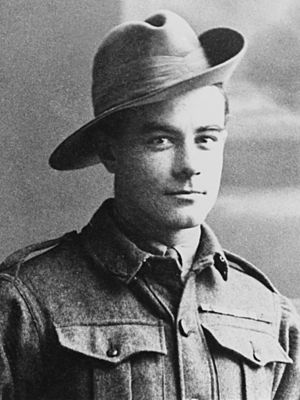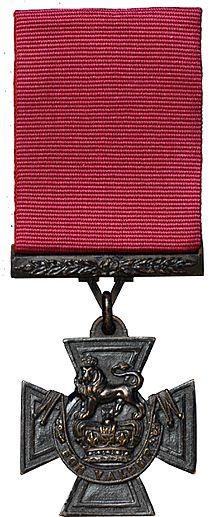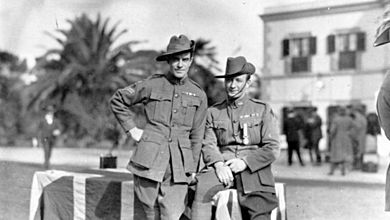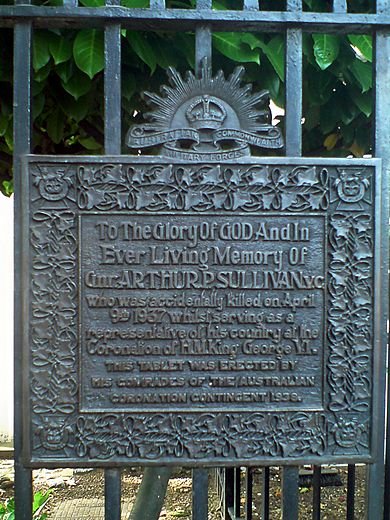Arthur Sullivan (Australian soldier) facts for kids
Quick facts for kids
Arthur Sullivan
|
|
|---|---|

Sullivan c. 1919
|
|
| Born | 27 November 1896 Prospect, South Australia |
| Died | 9 April 1937 (aged 40) Westminster, United Kingdom |
| Allegiance |
|
| Service/ |
|
| Years of service | 1918–1919 |
| Rank | Corporal |
| Unit |
|
| Battles/wars | |
| Awards | Victoria Cross |
| Spouse(s) |
Dorothy Frances Veale
(m. 1928) |
| Children | 3 |
Arthur Percy Sullivan was an Australian soldier known for his incredible bravery. He received the Victoria Cross (VC), which is the highest award for courage in battle for members of the British Armed Forces.
Born in South Australia in 1896, Arthur worked at a bank before joining the army in 1918 during World War I. Although the war ended before he saw action, he wanted to serve. So, he joined the British Army to help in the Allied intervention in the Russian Civil War in 1919.
While in northern Russia, Sullivan's group was crossing a river on a narrow bridge. They came under heavy enemy fire. Four soldiers fell into the deep, swampy river. Without hesitation, Sullivan jumped in and rescued all four, one by one. His heroic actions earned him the Victoria Cross.
After his military service, Sullivan returned to Australia and continued his banking career. In 1937, he was in London for the coronation of King George VI. Sadly, he died there after an accidental fall. Today, his Victoria Cross medal is displayed at the Australian War Memorial in Canberra.
Contents
Early Life and School Days
Arthur Percy Sullivan was born on 27 November 1896 in Prospect, South Australia. He was the only child of Arthur Monks Sullivan and Eliza Dobbs.
He went to Crystal Brook Public School starting in 1904. Later, from 1910, he attended Gladstone High School. Arthur was a bright student; he was the school captain and edited the school magazine. He was also a talented Australian rules football player.
After finishing school in mid-1913, Arthur started working at a branch of the National Bank of Australasia in Gladstone. He became a clerk in 1914. When World War I began, he was only 17. He wanted to join the army, but his parents would not let him.
He was promoted and moved to Broken Hill, New South Wales in 1915. The next year, he returned to South Australia to work in Maitland, where he became a bank teller. Arthur was active in his community. He played golf and Australian rules football. He also helped organize events for local soldiers. After he turned 20, his parents finally gave him permission to enlist.
Military Service and Bravery
Joining the Army
On 27 April 1918, Arthur Sullivan joined the Australian Imperial Force (AIF) as a private. He trained in Adelaide and then sailed to the United Kingdom in July. He was still training when World War I ended on 11 November 1918. So, he did not see any fighting in that war.
Even though World War I was over, Arthur wanted to experience active service. He heard about the North Russia Relief Force (NRRF). This force was part of the Allied intervention in the Russian Civil War. The Allies were helping forces against the Bolsheviks in Russia.
In May 1919, Sullivan left the AIF. On the very same day, he joined the British Army as a corporal to serve with the NRRF. He was one of about 150 Australians who volunteered. They were allowed to keep wearing their Australian uniforms.
Sullivan sailed to Russia in June 1919. He landed in Archangel and was sent up the Dvina River. He and his unit underwent intense training near the front lines.
The Dvina Offensive
In August, the NRRF launched an attack along the Dvina River. Arthur Sullivan's company was tasked with attacking villages from the rear. They marched nearly 50 kilometers through thick forests. On 10 August, they attacked the village of Kochamika. They easily defeated the enemy and captured the village.
They then pushed north, capturing more villages and many prisoners. However, their commander was killed. The enemy also cut off their escape route. The soldiers decided to break out and return to their lines. They had to move slowly because of their wounded comrades and many prisoners. Sullivan's platoon was the rearguard, protecting the column from behind.
Heroic Rescue at Sheika River
Around 2:30 AM on 11 August, the column reached the Sheika River. It was a wide, deep swamp, and they had to cross on a single-plank bridge. Sullivan's platoon was on the near bank. As the long line of soldiers crossed, they came under intense enemy rifle and machine gun fire.
Four men fell into the swamp. They were in danger of drowning from exhaustion and their injuries. Even though the enemy fire was heavy, Sullivan immediately jumped into the water to save them.
- The first man he saved was Lieutenant Charles Gordon-Lennox, who was already wounded.
- He then pulled out two more soldiers who had been hit or were struggling in the water.
- The fourth man was further away. Sullivan waded out with a broken piece of the bridge railing. The soldier grabbed it, and Sullivan pulled him to safety.
Without Sullivan's quick and brave actions, all four men would have drowned. The rest of the soldiers returned fire, pushing back the enemy. After the crossing, the column made it back to British lines.

For his incredible bravery, Arthur Sullivan was recommended for the Victoria Cross. This award is given for the most outstanding acts of courage in the face of the enemy. His VC was officially announced on 26 September 1919. Sullivan was very humble about his award. He said his comrades also deserved recognition.
Return Home
British forces left North Russia by late September. Sullivan returned to England in October. He was eager to go home to Australia. He sailed back on the troopship Nestor and arrived in Adelaide on 12 December 1919. He was welcomed as a hero.
The National Bank gave him money to buy a small house in Adelaide. On 13 July 1920, he received his Victoria Cross from Edward, the Prince of Wales, at Government House, Adelaide. Soon after, he became ill with malaria, which he had caught in Russia, but he recovered. Besides the VC, he also received the British War Medal and Victory Medal.
Later Life and Legacy
Arthur Sullivan was a popular man, known as the "Shy VC" because he was modest and did not like to talk about his brave actions. He returned to his job at the National Bank in Maitland in 1920. He was active in his community and enjoyed sports.
He was promoted in 1921 and moved around for his job. In 1925, he became an accountant in Orroroo. There, he met Dorothy Frances Veale, a nurse. They fell in love and married on 5 December 1928, in Victoria.
In 1929, Arthur and Dorothy moved to Sydney, where he worked at the bank's head office. They had three children: Moya (born 1931) and twins Brian and Shirley (born 1933). In 1934, Sullivan became the manager of a bank branch in Casino, New South Wales. He was well-respected in the town and involved in community groups like the Returned Sailors and Soldiers Imperial League of Australia.
Coronation Contingent and Sad End
In 1937, Arthur Sullivan was chosen to join the Australian group attending the coronation of King George VI and Queen Elizabeth in London. He also had a special task: to take the ashes of his friend, a British VC recipient named Arthur Evans, to Evans' family in the UK.
The Australian Coronation Contingent (ACC) was made up of 150 soldiers, sailors, and airmen. Sullivan was the only Victoria Cross recipient in the group. He rejoined the Royal Regiment of Australian Artillery as a gunner for the trip. The ACC sailed to London, arriving on 25 March.
On 9 April 1937, just over a month before the coronation, Sullivan was returning to his accommodation in London. As it was getting dark, he was surrounded by people asking for autographs. While trying to avoid them, he slipped and hit his head on the curb. He was also struck by a cyclist. He was taken to the hospital but died soon after, at the age of 40.
His death deeply saddened many people, including King George VI and Queen Elizabeth. Arthur Sullivan was given a full military funeral in London. His body was cremated, and his ashes were returned to Sydney with the ACC. A large procession, including nine other Victoria Cross recipients, honored him. His ashes were buried under a tree at the Northern Suburbs Crematorium in Sydney.
Remembering Arthur Sullivan
The National Bank helped Sullivan's wife, Dorothy, buy a cottage. In 1939, a photograph of Arthur was given to his old school in Crystal Brook. A bronze plaque was also made to remember him. It was placed on the railings of Wellington Barracks in London, near where he died, in 1946.
In 1980, Dorothy Sullivan passed away. She left Arthur's medals, including his Victoria Cross, to the Australian War Memorial in Canberra. They are now on display in the Hall of Valour, where heroes are remembered. In 1996, a plaque dedicated to him was unveiled in Crystal Brook. His name is also on the Maitland War Memorial.
See Also
- List of Australian Victoria Cross recipients
- North Russia intervention
- Australian contribution to the Allied Intervention in Russia 1918–1919




